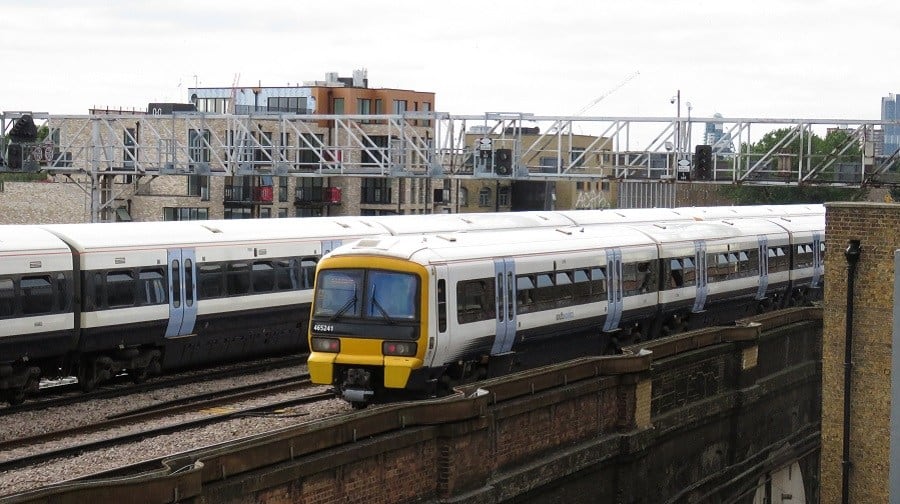Monday Accidents & Lessons Learned: Detrainment of Passengers onto Electrically Live Track

What happened
At 6:46 pm on Tuesday, November 7, 2017, a London Overground service from Dalston Junction to Battersea Park, operated by Arriva Rail London, came to a standstill shortly before reaching the station at Peckham Rye. A faulty component on the train caused the brakes to apply and the driver was unable to release them. There were approximately 450 passengers on the train.
The train driver communicated over the railway radio system to the service controller, train technicians, and the signaler. Following these conversations and with the assistance of a staff member from the Peckham Rye station, the train driver began to evacuate the passengers from the train via the door at the right-hand side of the driver’s cab at the front of the train. This involved passengers climbing down vertical steps to ground level—very close to the live electric conductor rail (third rail)—and walking along the side of the line for approximately 32 yards to Peckham Rye station. Eighty passengers detrained in this manner, walking alongside a track with 750 voltage direct current.
Soon afterward, an operations manager from Govia Thameslink Rail, which manages Peckham Rye station, contacted a member of the station staff and then understood the location of the evacuation and what was happening. The operations manager immediately instructed the driver to stop the evacuation and requested that he contact the signaler and his company’s controller for further instructions. After further advice from the control room-based train technicians, the driver isolated various train safety systems and was eventually able to release the brakes and move the train forward into the Peckham Rye station, arriving at approximately 7:44 pm. It was then possible for all the remaining passengers to leave the train normally. The train, then empty of passengers, proceeded to the depot at New Cross Gate. Although no one was hurt in the incident, the close proximity of the live conductor rail to the evacuating passengers posed a significant risk of serious harm.
How risk was introduced
The incident occurred because the driver initiated the detrainment of passengers without the traction current being switched off. He did this because he was given instructions by control room staff who had misunderstood the actual location of the stranded train. The train driver and the signaler did not reach a clear understanding about the actions that were required to safely detrain the passengers. The delay caused unrest among the passengers on the train and contributed to stress and task overload of the driver, which affected his decision-making. The driver’s experience and skills did not enable him to cope with these demands. Also, Network Rail—the organization which owns and manages most of the fixed assets of the United Kingdom railway network, including tracks, stations and signals—did not effectively implement its own procedures for managing an incident involving a stranded train.
Chief Inspector of Rail Accidents, Simon French, observed that, “Misunderstandings and confusion resulted in passengers being told to leave the safety of a train, climb down vertical steps above a live electric rail, and walk in darkness along an overgrown path to a station. About 80 people went through this before the evacuation was stopped, and it is very fortunate that no one was hurt.”
Underlying Factors
The underlying factors include:
- Arriva Rail London strategic command and Network Rail signaling staff were not adequately prepared to manage the incident.
- The United Kingdom railway industry standards and procedures relating to stranded trains place little emphasis on the need for practical training for those involved.
- The Rail Accident Investigation Branch (RAIB)—the British government agency that investigates rail accidents in the United Kingdom and the Channel Tunnel in order to find a cause, not to lay blame—also observed that there were a number of deficiencies in the training and briefing of staff and in the Arriva Rail London control room arrangements.
Recommendations
The RAIB has made three recommendations, directed to Arriva Rail London and Network Rail and intended to improve the response of the railway industry to train failures and other abnormal events, and has identified three learning points relating to the importance of following correct procedures when preparing to evacuate passengers from trains, ensuring that communications are properly understood, and passing on the details of incidents promptly and effectively.
The RAIB report names the negligence of the team to immediately identify and fix the technical issue, uncertainty and miscommunication between the driver and controllers, and anxiety and ‘task overload’ on the part of the driver who exhibited tension and a lack of ability to cope in response to the situation and passenger unrest.
“The driver’s limited experience of out-of-course events, and lack of practical training on what to do in such situations, combined with the number of tasks and demands on him during the incident, affected his ability to cope with the situation,” the report reads.
Managing director of Arriva Rail London, Will Rogers, commented, “We have conducted an internal investigation and have worked closely with Transport for London to enhance safety measures which address the learning from this incident.”
Network Rail stated that it is “already taking significant action to improve the way we respond to incidents of this kind.”
You may read the RAIB report here.
Circumstances can crop up anywhere at any time if proper and safe sequence and procedures are not planned and followed. We encourage you to learn and use the TapRooT® System to find and fix problems. Attend one of our courses. We offer a basic 2-Day Course and an advanced 5-Day Course. You may also contact us about having a course at your site.



